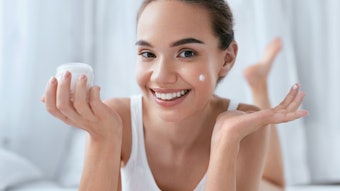
Formulating high-performance skin care systems at low pH levels (4.0 to 5.5) can be beneficial for consumers and formulators in many ways, acccording to Florence Pecquerie, applications scientist and formulator for Lubrizol. Here, she reviews the current knowledge on skin surface pH, discusses the importance of pH on the efficacy of organic acid preservatives in formulation and introduces a new crosslinked acrylic acid homopolymer.
Q: Can you touch on the acidic nature of human skin?
A: Heuss is the person most credited with discovering the acidic nature of skin in the late 19th century.1 That work was later validated in 1928 by Schade and Marchionini who introduced the acid mantle concept, which today helps illustrate the importance of an acidic skin surface pH on the vital role of skin as a protective barrier.2-6
Today, most literature suggests that the acidic character of the skin surface is imparted by various substances found in the stratum corneum (SC), such as some of the well-known components of the Natural Moisturizing Factor including amino-acids, urocanic acid, etc. The skin surface pH of normal, healthy skin falls in the 4.0 to 6.0 range, and it is generally accepted that, on average, the surface of normal skin is around pH 5. Lambers et al. estimated that about 50% of the literature reported skin surface pH values below 5.4
Q: How important is an acidic skin surface?
A: It is generally recognized that an acidic skin surface pH promotes a healthy SC.5 However, an elevated skin surface pH could:
- potentially disrupt the SC’s barrier function by impairing the formation of the lipid lamellar structure,
- alter its integrity by interfering with the natural desquamation process (desquamation is the shedding of superficial corneocytes) and
- compromise the skin’s antimicrobial defense by impairing the adhesion of the resident microflora and/or favoring the growth of pathogenic microorganisms.
Q: Are there factors that might influence the skin surface pH?
A: Endogenous factors may influence skin surface pH to some extent.3,4,6 They include:
- Body Site: Skin surface pH is relatively similar (4.7 to 5.5) in different areas of the body except for sites that are susceptible to increased moisture (axilla areas, groin and foot), which generally show a higher skin surface pH.
- Gender: Although here, data from the literature is conflicting whether a skin pH difference exists between males and females.
- Fitzpatrick Skin Type:3 It is suggested that type IV and V skin has a lower skin surface pH than type I and II skin,
- Age, etc.
Exogenous factors such as hygienic or beauty habits might also influence to some extent the skin surface pH. It has been observed that the skin surface pH of the volar forearm of volunteers treated with a bar soap was increased noticeably and that the skin surface pH slowly decreased back to its natural value in about 6 hours.4 So, whenever possible, formulating bath and shower products as well as skin care products at the natural skin surface pH should be beneficial for the consumer.
Q: Are there other reasons to formulate at acidic pH?
A: Yes, this can be useful for optimizing the efficacy of organic acid preservatives. Because microorganisms develop so well in water (most of them between pH 4.0 and 8.0), every cosmetic product that contains an aqueous phase should use a preservative. Employing benzoic acid or sorbic acid and other organic acids as fungicides is currently one of the key formulation solutions to evolve away from the traditional preservative systems that are based on parabens, formaldehyde donors or isothiazolinone and often perceived negatively by consumers. Formulations preserved with benzoic and sorbic acids are generally formulated at pH 5.0 to 5.5 maximum.
Q: Would you explain why an acidic pH is required to optimize the antimicrobial activity of organic acid preservatives?
A: Organic acids are weak acids, which means they do not dissociate completely in water. In a formulation, they are in equilibrium with their salt forms. The antimicrobial activity of organic acid preservatives is linked to the undissociated acid form, which allows the acid to penetrate the membrane of microorganisms. Conversely, the dissociated salt form cannot easily cross the phospholipid plasma membrane;7 therefore, it is necessary to optimize the amount of acid form in the formulation. The pH and the acidity (pKa) of those weak organic acids reflect the amount of undissociated acid form. For example, if the pH is equal to the pKa of benzoic acid (pKa = 4.2), the formulator must have 50% of the benzoic acid form in the media and the rest in ionized (benzoate) form. In other words, the lower the pH, the higher the concentration of acid present in the formulation for preservation activity.
Q: What are the challenges of using organic acid preservatives in skin care formulations?
A Currently, organic acids are not ideal solutions. They are effective against fungi and have some activity against bacteria,8 but to ensure proper protection of skin care formulations, it is necessary to combine them with another preservative (i.e., benzyl alcohol and phenoxyethanol), small amounts of a chelating agent (i.e., phytic acid and tetrasodium glutamate diacetate) or other antimicrobial agents or preservative boosters (i.e., ethylhexylglycerin, caprylyl or pentylene glycol, ethanol and glyceryl caprylate).
Sorbic acid is susceptible to oxidation and can lead to discoloration during storage. It is the same for dehydroacetic acid, which tends to yellow over time. The use of an antioxidant is advised. There is also a need to balance the irritation potential of organic acid preservatives. They are commonly formulated at 5.0 to 5.5 in skin care formulations. Last but not least, since they are electrolytes, they can reduce the overall viscosity of the emulsion.
Q: What role does the new Lubrizol Carbopol® Ultrez 30 Polymer play?
A: Carbopol® Ultrez 30 polymer (INCI: Carbomer) is a new crosslinked acrylic acid homopolymer that provides a solution for formulating skin care products with medium to high viscosities. It allows the formulator to achieve desired rheological and aesthetic properties in the presence of those electrolytes or acidic actives that are desirable and trendy in today’s consumer beauty products. Its improved electrolyte tolerance and broad pH compatibility make it ideal for formulating at the natural skin surface pH, or for formulations containing botanical extracts or water-soluble salts, or acidic ingredients such as organic acid preservatives (see Figure 1).
Q: What should someone do if he or she wants to know more?
A: For product details, more information, samples and starting formulations, visit our website, like us on Facebook or follow us on Twitter.
References
1. E Heuss, Die Reaktion des Schweisses beim gesunden Menschen, Monatshefte für praktische Dermatologie 14 400-409 (1892)
2. H Schade and A Marchionini, Der Säuremantel der Haut (nach Gaskettenmessungen), Klinische Wochenschrift 7 12-14 (1928)
3. G Yosipovitch and M Ali Saba, Skin pH: From Basic Science to Basic Skin Care, Acta Dermato-Venereologica 93 1-9 (2013)
4. H Lambers, S Piessens, A Bloem, H Pronk and P Finkel, Natural Skin Surface pH is on Average below 5, which is Beneficial for its Resident Flora, Int J Cosm Sci 28(5) 359-70 (2006)
5. MH Schmid-Wendtner and HC Korting, The pH of the Skin Surface and its Impact on the Barrier Function, Skin Pharmacology and Physiology 19 296-302 (2006)
6. JW Wiechers, Formulating at pH 4-5: How Lower pH Benefits the Skin and Formulations, Cosm & Toil 123(12) 61-70 (2008)
7. S Brul S and P Coote, Preservative agents in foods – Mode of action and microbial resistance mechanism, Int J Food Microbiology 50(1-2) 1-17 (1999)
8. DC Steinberg, Preservatives for Cosmetics, 3rd edition, Allured Books: Carol Stream, Ill., USA(2012)
Disclaimer:
The above paid-for content was produced by and posted on behalf of the Sponsor. Content provided is generated solely by the Sponsor or its affiliates, and it is the Sponsor’s responsibility for the accuracy, completeness and validity of all information included. Cosmetics & Toiletries takes steps to ensure that you will not confuse sponsored content with content produced by Cosmetics & Toiletries and governed by its editorial policy.










